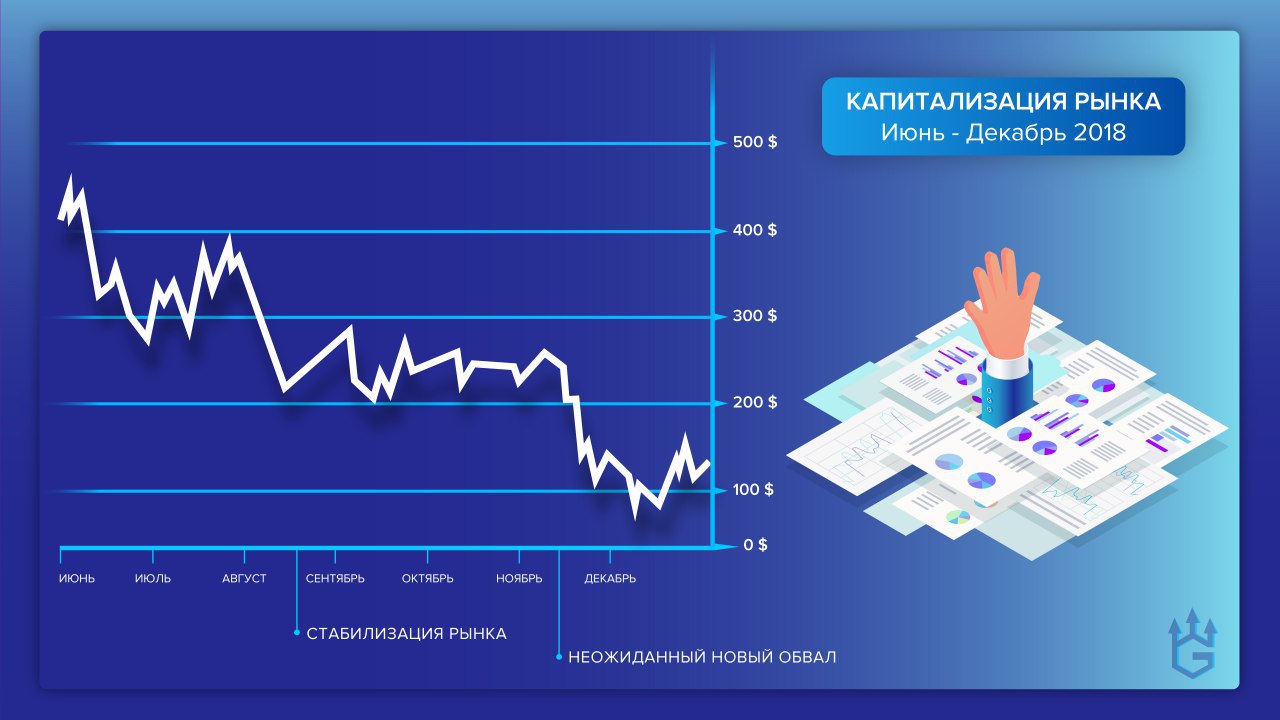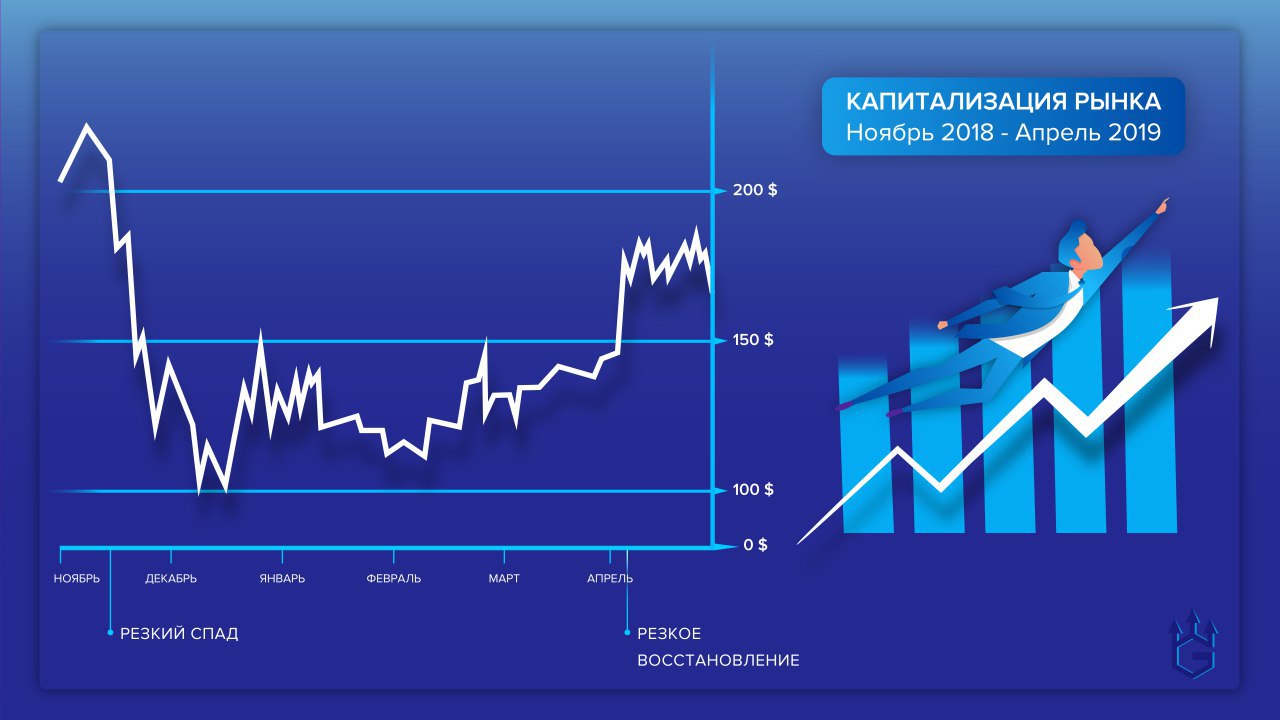Cryptocurrency: lives or dies? Part 3
Part 3. Causes of the collapse and market recovery
In the first parts of our story, we gave political and general economic arguments as to why crypto-wines are not only alive, but also booming. In this part of the cycle, we will try to consider in more detail some specific factors that worked during the collapse of the market in 2018 and the beginning of its recovery in 2019.
Winter-Spring: Chicago futures and the overall overheated market
A significant part of the rise of the crypto market at the end of 2017 was caused by waiting for the start of trading in Bitcoin futures on the Chicago commodity exchanges and CME and CBOE. This excitement was mainly ideological motivated. As we wrote in the last part, the start of trading meant that the crypto market was recognized by the American financial establishment and, in part, even by the state (which had previously stopped all attempts to bring cryptocurrencies to traditional exchanges). It was in December 2017 that the leadership of the SEC was forced to declare that Bitcoin will now have to be considered.
But it was the start of futures trading in mid-December that served as a trigger for the beginning of a market downturn. And this already had not ideological, but purely economic reasons: inequality between the sellers and buyers of BTC. Due to the abundance of mining companies, BTC offer was stable and massive. Miner is forced to cash out at least part of the cryptocurrency - both to secure profits, and to pay for electricity and other business content. As for the demand for BTC, then with him in December 2017 it was not so optimistic. Experienced Chicago financiers understood that BTC was highly overvalued, and buying it at this rate is dangerous. It is much easier to force miners to lower prices: with a lack of demand, they have nowhere to go.
')

Many analysts believe that it was this factor that led to the beginning of the decline in the BTC rate, and behind it the other cryptocurrencies. And when the decline really began, the miners began to enter into futures contracts at ever lower prices in order to insure against a complete collapse, guaranteed to get a “bird in the hand”. This has contributed to the downward trend for several months.
Of course, Bitcoin futures were not the only factor in a recession. The market was overheated - just like in 2013. This bubble simply could not burst. Futures worked only as
trigger mechanism, they also largely determined the rate of decline - the speed with which the miners were ready to make new concessions.
Summer-Autumn: reduced supply and interest of new investors
Although in winter and spring mining companies provided a stable supply of BTC and other cryptocurrencies (which did not participate in the futures market, but also became cheaper), it became clear in summer: with such trends, mining will soon become unprofitable. In countries with relatively expensive electricity, even the most profitable currencies from the whattomine.org list began to approach the payback limit. Continuing to make concessions to the “bears” in this situation was increasingly difficult. Some companies have chosen to suspend operations rather than work at a loss.
Many ordinary investors also went into the “thick defense”, ceasing to sell the depreciating currencies. Their logic was simple. Imagine that you bought BTC for $ 15-20 thousand, and he fell to $ 6-7. You have a choice: either sell it for cheap, “signing up” for the loss of most of the investment, or hope for a new rise in the market. An increasing percentage of investors began to choose the second option.
As a result, market supply declined and the decline slowed down. By September, the BTC course has almost stabilized at around $ 6,500. Demand in the market began to grow, and immediately from three independent groups of investors.
Investors already familiar with the crypto market and decided that the bottom of the fall is close (especially in September).
New unexpected investors - residents of countries with distressed economies and high inflation of national currencies: Turkey, Venezuela, Argentina. If earlier in crises fear of inflation inclined citizens of many countries to buy dollars and euros, then this time cryptocurrency seemed to them more promising. Interest was truly massive. The August survey showed, for example, that the number of cryptocurrency holders in Turkey is already twice as high as the EU average: 18% versus 9%.
Large institutional investors from the United States and other leading countries - pension funds and other reputable players who had previously avoided cryptoactive assets due to volatility and uncertain legislative status, but gradually understood the promise. An important factor here was the mixing of the political climate around cryptocurrencies, which we talked about in the last part.
Of these three groups of investors, the first and the second were directly active, while the third took a wait-and-see attitude, but with clear intentions to invest serious sums. Increased investor interest in almost all of autumn made the rate of basic cryptocurrencies very stable. In October, the BTC rate even showed higher stability than the US stock market, for some time becoming a defensive asset of gold type (a role that analysts had long promised BTC).

But despite all this, in November 2018 there was another collapse.
November-April: the bottom is reached, recovery begins?
The new collapse began on November 14, abruptly and unexpectedly. Literally in an hour, the Bitcoin (BTC) rate hit $ 800, and in the following days the market collapsed even deeper. By the end of November, the BTC and the entire market slipped by more than a third. BTC - from $ 6300 to $ 4000, market capitalization - from $ 210 billion to $ 130 billion
There are two main versions of what happened. Which, however, do not contradict each other.
The version is fundamental and obvious . Large financial circles - the ones that looked at cryptocurrencies in the summer and autumn - decided to buy them, but, if possible, as cheap as possible. How specifically to bring down the price - a separate question. The fact is that they had such an interest. This version does not explain why the collapse was so dramatic, but explains why it happened at all and was quite deep.
Version detailed and conspiratorial. The collapse was caused by a scandal around the markups on the South Korean stock exchange Bithumb, bought by the Singapore company BK Global Consortium. In September-October, this company decided to bring the stock exchange to the world leaders by conducting promotions, supporting traders with high transaction volumes, etc. In a short time, the trading volumes at Bithumb almost quadrupled. But in early November, the service Crypto Exchange Ranks (CER) accused Bithumb of cheating. After 3 days, the weight of the Korean won in the world crypto-trade fell by an order of magnitude, and after 3 days the “same” market collapse began. This version explains the lightning speed of collapse, although it is not necessary to believe in it. A fall could have had another momentary cause. More importantly, many forces were interested in this fall.
In the next 4 months, the market could not recover from this blow. In December, he additionally sank, January “lay at the bottom”, from February it began to recover carefully, but only in April it really sharply jumped up. Again, literally in an hour, the bitcoin rate grew by the same $ 800, and again an additional slower rise followed. In less than a month, the market capitalization increased from $ 140 billion to $ 180, and this trend continues.

What happened in early April, and why did the take-off scenario remind us of the November fall scenario? No matter how ridiculous, the fundamental reason for the April take-off coincides with the cause of the November fall: the same investors, who in November wanted to drop the market to buy, later became interested in raising it.
Already in December 2018, many experts talked about the critical oversold cryptocurrency, the unprecedented shortage of vendors. If in November, September investors were still ready to succumb to a sudden panic (to minimize losses), then in December everyone was in too deep a minus to fix losses. The “hodl” tactic (the popular misinformed word “hold”, to safeguard assets) became the only reasonable one. Further depreciation, even if someone wanted it, has become too unlikely. Large and small investors gradually began to realize that it was time to buy. As a consequence, in February the courses went up. By the end of March it became clear that almost no one was interested in the new collapse of the courses. Everyone wants to buy, everyone is waiting for the rise. And with such a mood for a sharp take-off, just a “face” signal is enough, a sharp click: fly in, or you won't have time!
Who specifically made this click is not so important. Probably one of the major players, the so-called "whales". Perhaps it was again one of the major exchanges. In any case, this event was expected by many.
Conclusion
To tell you the truth, this cycle was conceived in March, when the rise was just beginning, and it was not clear to many whether the cryptracks were alive or dead. Hence the name. But now, in April, there are hardly any doubts on this point: there is an obvious rise both in terms of trading volumes and asset rates. Nevertheless, we told a little more than can be seen from the current graphs.
Cryptocurrencies are becoming an integral part of the economy. If earlier they were predominantly a speculative asset, today they are increasingly accepted as a means of payment. If earlier they were a lot of ardent enthusiasts of the free market, now many states have recognized them. If earlier, many admitted the idea that this is only a momentary HYIP, now it is clear that digital assets have their footing and are steadily gaining popularity despite the dizzying bubbles that would easily have crossed “just a dummy”.
The question of whether to be a cryptorink or not to be - solved. What will it be specifically? What currencies will take up, what non-currency blockchain projects will “shoot”, how many popular assets will remain, how the global economy and politics will change in general - we will see a lot of this in the coming years.
And in the next small post we will analyze what $ 5200 can turn into if we invest them in Bitcoin now. We will show that even in the absence of a new roller coaster, after 5 years they may well exceed $ 300,000 - and this is an estimate taken far from the ceiling.
Analytics Department at Trident
Source: https://habr.com/ru/post/450644/
All Articles